Product Info Summary
| SKU: | A00812-1 |
|---|---|
| Size: | 100 μg/vial |
| Reactive Species: | Human |
| Host: | Rabbit |
| Application: | ELISA, IHC, WB |
Customers Who Bought This Also Bought
Product info
Product Name
Anti-CD163 Antibody Picoband®
SKU/Catalog Number
A00812-1
Size
100 μg/vial
Form
Lyophilized
Description
Boster Bio Anti-CD163 Antibody Picoband® catalog # A00812-1. Tested in ELISA, IHC, WB applications. This antibody reacts with Human. The brand Picoband indicates this is a premium antibody that guarantees superior quality, high affinity, and strong signals with minimal background in Western blot applications. Only our best-performing antibodies are designated as Picoband, ensuring unmatched performance.
Storage & Handling
Store at -20˚C for one year from date of receipt. After reconstitution, at 4˚C for one month. It can also be aliquotted and stored frozen at -20˚C for six months. Avoid repeated freeze-thaw cycles.
Cite This Product
Anti-CD163 Antibody Picoband® (Boster Biological Technology, Pleasanton CA, USA, Catalog # A00812-1)
Host
Rabbit
Contents
Each vial contains 4mg Trehalose, 0.9mg NaCl, 0.2mg Na2HPO4, 0.05mg NaN3.
Clonality
Polyclonal
Isotype
Rabbit IgG
Immunogen
E. coli-derived human CD163 recombinant protein (Position: T47-E201).
*Blocking peptide can be purchased. Costs vary based on immunogen length. Contact us for pricing.
Cross-reactivity
No cross-reactivity with other proteins.
Reactive Species
A00812-1 is reactive to CD163 in Human
Reconstitution
Add 0.2ml of distilled water will yield a concentration of 500ug/ml.
Observed Molecular Weight
150 kDa
Calculated molecular weight
53384 MW
Background of CD163
CD163 (Cluster of Differentiation 163) is a protein that in humans is encoded by the CD163 gene. The protein encoded by this gene is a member of the scavenger receptor cysteine-rich (SRCR) superfamily, and is exclusively expressed in monocytes and macrophages. It functions as an acute phase-regulated receptor involved in the clearance and endocytosis of hemoglobin/haptoglobin complexes by macrophages, and may thereby protect tissues from free hemoglobin-mediated oxidative damage. This protein may also function as an innate immune sensor for bacteria and inducer of local inflammation. Alternatively spliced transcript variants encoding different isoforms have been described for this gene.
Antibody Validation
Boster validates all antibodies on WB, IHC, ICC, Immunofluorescence, and ELISA with known positive control and negative samples to ensure specificity and high affinity, including thorough antibody incubations.
Application & Images
Applications
A00812-1 is guaranteed for ELISA, IHC, WB Boster Guarantee
Assay Dilutions Recommendation
The recommendations below provide a starting point for assay optimization. The actual working concentration varies and should be decided by the user.
Western blot, 0.25-0.5μg/ml
Immunohistochemistry (Paraffin-embedded Section), 2-5μg/ml
ELISA, 0.1-0.5μg/ml
Positive Control
WB: human HCCT tissue, human HCCP tissue
IHC: human gall bladder adenosquamous carcinoma tissue, human liver cancer tissue, human lung cancer tissue, human placenta tissue, human rencal cancer tissue, human appendiceal adenocarcinoma tissue, human spleen tissue
Validation Images & Assay Conditions
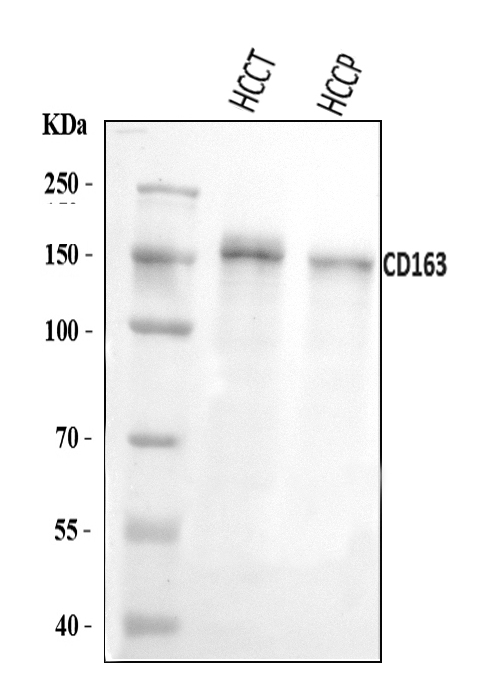
Click image to see more details
Figure 1. Western blot analysis of CD163 using anti-CD163 antibody (A00812-1).
Electrophoresis was performed on a 5-20% SDS-PAGE gel at 70V (Stacking gel) / 90V (Resolving gel) for 2-3 hours. The sample well of each lane was loaded with 30 ug of sample under reducing conditions.
Lane 1: human HCCT tissue lysates,
Lane 2: human HCCP tissue lysates.
After electrophoresis, proteins were transferred to a nitrocellulose membrane at 150 mA for 50-90 minutes. Blocked the membrane with 5% non-fat milk/TBS for 1.5 hour at RT. The membrane was incubated with rabbit anti-CD163 antigen affinity purified polyclonal antibody (Catalog # A00812-1) at 0.5 μg/mL overnight at 4°C, then washed with TBS-0.1%Tween 3 times with 5 minutes each and probed with a goat anti-rabbit IgG-HRP secondary antibody at a dilution of 1:5000 for 1.5 hour at RT. The signal is developed using an Enhanced Chemiluminescent detection (ECL) kit (Catalog # EK1002) with Tanon 5200 system. A specific band was detected for CD163 at approximately 150 kDa. The expected band size for CD163 is at 128 kDa.
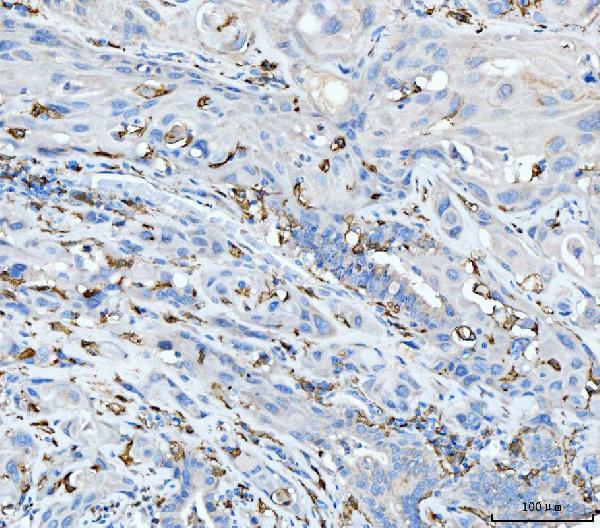
Click image to see more details
Figure 2. IHC analysis of CD163 using anti-CD163 antibody (A00812-1).
CD163 was detected in a paraffin-embedded section of human gall bladder adenosquamous carcinoma tissue. Heat mediated antigen retrieval was performed in EDTA buffer (pH 8.0, epitope retrieval solution). The tissue section was blocked with 10% goat serum. The tissue section was then incubated with 2 μg/ml rabbit anti-CD163 Antibody (A00812-1) overnight at 4°C. Biotinylated goat anti-rabbit IgG was used as secondary antibody and incubated for 30 minutes at 37°C. The tissue section was developed using Strepavidin-Biotin-Complex (SABC) (Catalog # SA1022) with DAB as the chromogen.
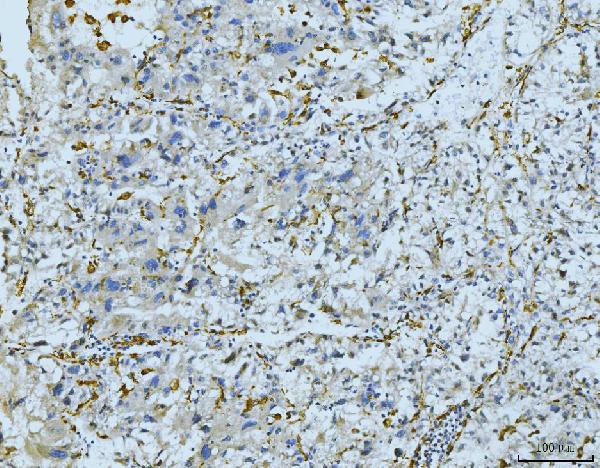
Click image to see more details
Figure 3. IHC analysis of CD163 using anti-CD163 antibody (A00812-1).
CD163 was detected in a paraffin-embedded section of human liver cancer tissue. Heat mediated antigen retrieval was performed in EDTA buffer (pH 8.0, epitope retrieval solution). The tissue section was blocked with 10% goat serum. The tissue section was then incubated with 2 μg/ml rabbit anti-CD163 Antibody (A00812-1) overnight at 4°C. Biotinylated goat anti-rabbit IgG was used as secondary antibody and incubated for 30 minutes at 37°C. The tissue section was developed using Strepavidin-Biotin-Complex (SABC) (Catalog # SA1022) with DAB as the chromogen.
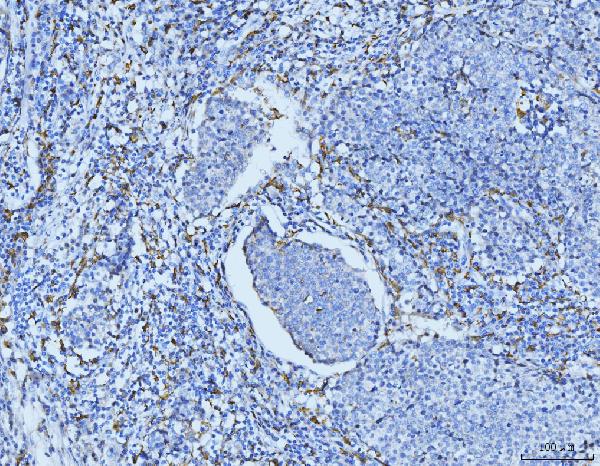
Click image to see more details
Figure 4. IHC analysis of CD163 using anti-CD163 antibody (A00812-1).
CD163 was detected in a paraffin-embedded section of human lung cancer tissue. Heat mediated antigen retrieval was performed in EDTA buffer (pH 8.0, epitope retrieval solution). The tissue section was blocked with 10% goat serum. The tissue section was then incubated with 2 μg/ml rabbit anti-CD163 Antibody (A00812-1) overnight at 4°C. Biotinylated goat anti-rabbit IgG was used as secondary antibody and incubated for 30 minutes at 37°C. The tissue section was developed using Strepavidin-Biotin-Complex (SABC) (Catalog # SA1022) with DAB as the chromogen.
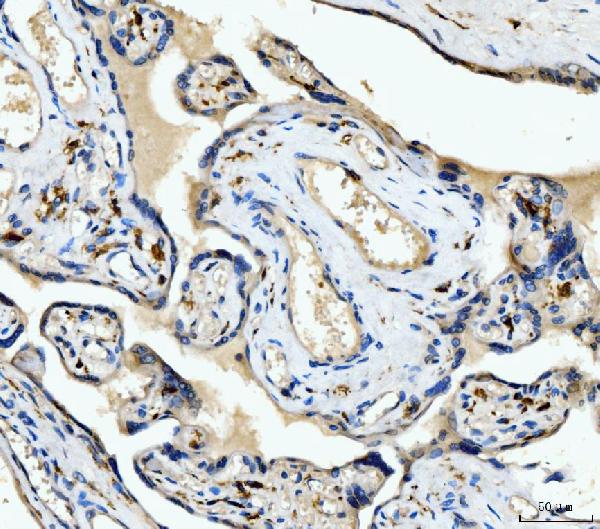
Click image to see more details
Figure 5. IHC analysis of CD163 using anti-CD163 antibody (A00812-1).
CD163 was detected in a paraffin-embedded section of human placenta tissue. Heat mediated antigen retrieval was performed in EDTA buffer (pH 8.0, epitope retrieval solution). The tissue section was blocked with 10% goat serum. The tissue section was then incubated with 2 μg/ml rabbit anti-CD163 Antibody (A00812-1) overnight at 4°C. Biotinylated goat anti-rabbit IgG was used as secondary antibody and incubated for 30 minutes at 37°C. The tissue section was developed using Strepavidin-Biotin-Complex (SABC) (Catalog # SA1022) with DAB as the chromogen.
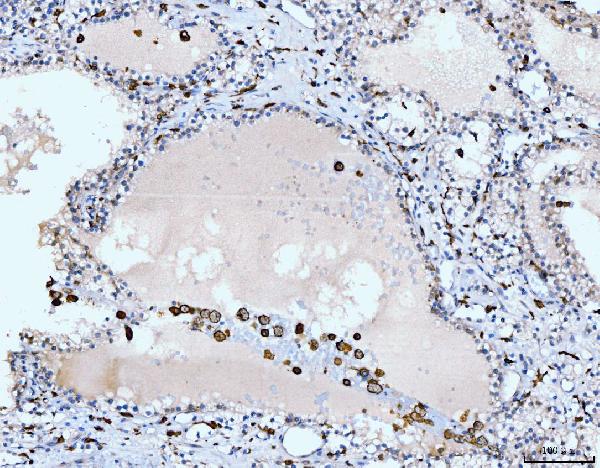
Click image to see more details
Figure 6. IHC analysis of CD163 using anti-CD163 antibody (A00812-1).
CD163 was detected in a paraffin-embedded section of human rencal cancer tissue. Heat mediated antigen retrieval was performed in EDTA buffer (pH 8.0, epitope retrieval solution). The tissue section was blocked with 10% goat serum. The tissue section was then incubated with 2 μg/ml rabbit anti-CD163 Antibody (A00812-1) overnight at 4°C. Biotinylated goat anti-rabbit IgG was used as secondary antibody and incubated for 30 minutes at 37°C. The tissue section was developed using Strepavidin-Biotin-Complex (SABC) (Catalog # SA1022) with DAB as the chromogen.
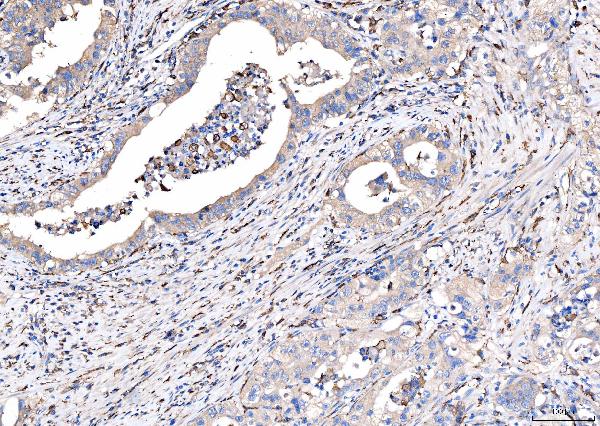
Click image to see more details
Figure 7. IHC analysis of CD163 using anti-CD163 antibody (A00812-1).
CD163 was detected in a paraffin-embedded section of human appendiceal adenocarcinoma tissue. Heat mediated antigen retrieval was performed in EDTA buffer (pH 8.0, epitope retrieval solution). The tissue section was blocked with 10% goat serum. The tissue section was then incubated with 2 μg/ml rabbit anti-CD163 Antibody (A00812-1) overnight at 4°C. Biotinylated goat anti-rabbit IgG was used as secondary antibody and incubated for 30 minutes at 37°C. The tissue section was developed using Strepavidin-Biotin-Complex (SABC) (Catalog # SA1022) with DAB as the chromogen.
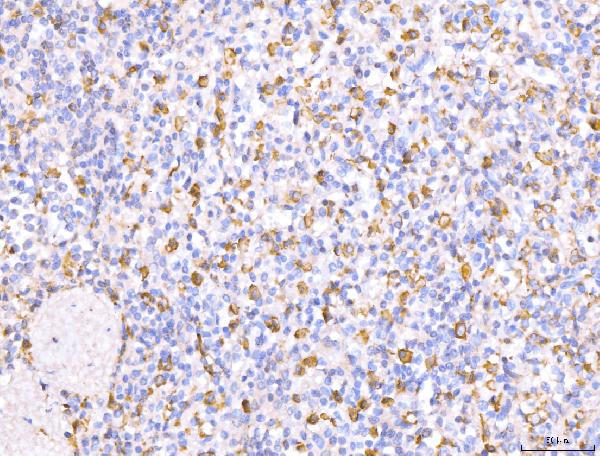
Click image to see more details
Figure 8. IHC analysis of CD163 using anti-CD163 antibody (A00812-1).
CD163 was detected in a paraffin-embedded section of human spleen tissue. Heat mediated antigen retrieval was performed in EDTA buffer (pH 8.0, epitope retrieval solution). The tissue section was blocked with 10% goat serum. The tissue section was then incubated with 2 μg/ml rabbit anti-CD163 Antibody (A00812-1) overnight at 4°C. Biotinylated goat anti-rabbit IgG was used as secondary antibody and incubated for 30 minutes at 37°C. The tissue section was developed using Strepavidin-Biotin-Complex (SABC) (Catalog # SA1022) with DAB as the chromogen.
Protein Target Info & Infographic
Gene/Protein Information For CD163 (Source: Uniprot.org, NCBI)
Gene Name
CD163
Full Name
Scavenger receptor cysteine-rich type 1 protein M130
Weight
53384 MW
Alternative Names
Scavenger receptor cysteine-rich type 1 protein M130; Hemoglobin scavenger receptor; CD163; Soluble CD163; sCD163; CD163; M130 CD163 M130, MM130, SCARI1 CD163 molecule scavenger receptor cysteine-rich type 1 protein M130|hemoglobin scavenger receptor|macrophage-associated
*If product is indicated to react with multiple species, protein info is based on the gene entry specified above in "Species".For more info on CD163, check out the CD163 Infographic

We have 30,000+ of these available, one for each gene! Check them out.
In this infographic, you will see the following information for CD163: database IDs, superfamily, protein function, synonyms, molecular weight, chromosomal locations, tissues of expression, subcellular locations, post-translational modifications, and related diseases, research areas & pathways. If you want to see more information included, or would like to contribute to it and be acknowledged, please contact [email protected].
Specific Publications For Anti-CD163 Antibody Picoband® (A00812-1)
Hello CJ!
A00812-1 has been cited in 4 publications:
*The publications in this section are manually curated by our staff scientists. They may differ from Bioz's machine gathered results. Both are accurate. If you find a publication citing this product but is missing from this list, please let us know we will issue you a thank-you coupon.
ACS Appl.Bio Mater.2020,3,7,4335–4347 Publication Date:June 11,2020 https://doi.org/10.1021/acsabm.0c00368
Species: Mouse
A00812-1 usage in article: APP:IF, SAMPLE:MAMMARY TISSUE, DILUTION:1:200
Farag AGA,El Askary SA,Fathy WM,Elbassal F,Azzam AA,Tayel NR,Abdul Karim SS,Shehata WA. Relationship Between sCD163 and mCD163 and Their Implication in the Detection and Typing of Leprosy. Clin Cosmet Investig Dermatol.2020 Jun 2;13:379-389.doi:10.2147/CC
Species: Human
A00812-1 usage in article: APP:IHC, SAMPLE:BLOOD, DILUTION:NA
il-17 induces macrophages to M2-like phenotype via nF-%u03BAB
SIV Infection Impairs the Central Nervous System in Chinese Rhesus Macaques
Recommended Resources
Here are featured tools and databases that you might find useful.
- Boster's Pathways Library
- Protein Databases
- Bioscience Research Protocol Resources
- Data Processing & Analysis Software
- Photo Editing Software
- Scientific Literature Resources
- Research Paper Management Tools
- Molecular Biology Software
- Primer Design Tools
- Bioinformatics Tools
- Phylogenetic Tree Analysis
Customer Reviews
Have you used Anti-CD163 Antibody Picoband®?
Submit a review and receive an Amazon gift card.
- $30 for a review with an image
0 Reviews For Anti-CD163 Antibody Picoband®
Customer Q&As
Have a question?
Find answers in Q&As, reviews.
Can't find your answer?
Submit your question
17 Customer Q&As for Anti-CD163 Antibody Picoband®
Question
Could you please verify if mouse and rat are reactive species for Product A00812-1?
Verified customer
Asked: 2021-11-10
Answer
Mouse and rat are not reactive species for the Anti-CD163 Antibody Picoband™ (A00812-1).
Boster Scientific Support
Answered: 2021-11-11
Question
We are interested in to test anti-CD163 antibody A00812-1 on human liver for research purposes, then I may be interested in using anti-CD163 antibody A00812-1 for diagnostic purposes as well. Is the antibody suitable for diagnostic purposes?
Verified Customer
Verified customer
Asked: 2019-12-19
Answer
The products we sell, including anti-CD163 antibody A00812-1, are only intended for research use. They would not be suitable for use in diagnostic work. If you have the means to develop a product into diagnostic use, and are interested in collaborating with us and develop our product into an IVD product, please contact us for more discussions.
Boster Scientific Support
Answered: 2019-12-19
Question
Is a blocking peptide available for product anti-CD163 antibody (A00812-1)?
Verified Customer
Verified customer
Asked: 2019-09-27
Answer
We do provide the blocking peptide for product anti-CD163 antibody (A00812-1). If you would like to place an order for it please contact [email protected] and make a special request.
Boster Scientific Support
Answered: 2019-09-27
Question
Please see the WB image, lot number and protocol we used for liver using anti-CD163 antibody A00812-1. Please let me know if you require anything else.
Verified Customer
Verified customer
Asked: 2019-08-28
Answer
Thank you very much for the data. Our lab team are working to resolve this as quickly as possible, and we appreciate your patience and understanding! You have provided everything we needed. Please let me know if there is anything you need in the meantime.
Boster Scientific Support
Answered: 2019-08-28
Question
Would anti-CD163 antibody A00812-1 work for ICC with liver?
Verified Customer
Verified customer
Asked: 2019-07-16
Answer
According to the expression profile of liver, CD163 is highly expressed in liver. So, it is likely that anti-CD163 antibody A00812-1 will work for ICC with liver.
Boster Scientific Support
Answered: 2019-07-16
Question
We have been able to see staining in mouse spleen. Any tips? Is anti-CD163 antibody supposed to stain spleen positively?
M. Carter
Verified customer
Asked: 2019-05-27
Answer
From literature spleen does express CD163. From Uniprot.org, CD163 is expressed in esophagus, spleen, plasma, liver, among other tissues. Regarding which tissues have CD163 expression, here are a few articles citing expression in various tissues:
Liver, Pubmed ID: 19159218, 24275569
Plasma, Pubmed ID: 16335952
Spleen, Pubmed ID: 15489334
Boster Scientific Support
Answered: 2019-05-27
Question
My lab would like using your anti-CD163 antibody for acute-phase response studies. Has this antibody been tested with western blotting on human tonsil tissue? We would like to see some validation images before ordering.
K. Williams
Verified customer
Asked: 2019-01-18
Answer
Thanks for your inquiry. This A00812-1 anti-CD163 antibody is validated on human tonsil tissue, hela whole cell lysates, placenta tissue, mouse spleen tissue, nih3t3 whole cell lysates, rat spleen tissue. It is guaranteed to work for ELISA, Flow Cytometry, IHC, ICC, WB in human, mouse, rat. Our Boster guarantee will cover your intended experiment even if the sample type has not been be directly tested.
Boster Scientific Support
Answered: 2019-01-18
Question
We are currently using anti-CD163 antibody A00812-1 for mouse tissue, and we are content with the WB results. The species of reactivity given in the datasheet says human, mouse, rat. Is it likely that the antibody can work on zebrafish tissues as well?
Verified Customer
Verified customer
Asked: 2019-01-16
Answer
The anti-CD163 antibody (A00812-1) has not been tested for cross reactivity specifically with zebrafish tissues, though there is a good chance of cross reactivity. We have an innovator award program that if you test this antibody and show it works in zebrafish you can get your next antibody for free. Please contact me if I can help you with anything.
Boster Scientific Support
Answered: 2019-01-16
Question
I appreciate helping with my inquiry over the phone. Here are the WB image, lot number and protocol we used for liver using anti-CD163 antibody A00812-1. Let me know if you need anything else.
Verified Customer
Verified customer
Asked: 2018-07-24
Answer
We appreciate the data. You have provided everything we needed. Our lab team are working to resolve your inquiry as quickly as possible, and we appreciate your patience and understanding! Please let me know if there is anything you need in the meantime.
Boster Scientific Support
Answered: 2018-07-24
Question
I see that the anti-CD163 antibody A00812-1 works with ICC, what is the protocol used to produce the result images on the product page?
Verified Customer
Verified customer
Asked: 2018-07-05
Answer
You can find protocols for ICC on the "support/technical resources" section of our navigation menu. If you have any further questions, please send an email to [email protected]
Boster Scientific Support
Answered: 2018-07-05
Question
Can you help my question with product A00812-1, anti-CD163 antibody. I was wondering if it would be possible to conjugate this antibody with biotin. I would need it to be without BSA or sodium azide. I am planning on using a buffer exchange of sodium azide with PBS only. Would there be problems for me to conjugate the antibody and store it in -20 degrees in small aliquots?
Verified Customer
Verified customer
Asked: 2018-04-05
Answer
We do not advise storing this antibody with PBS buffer only in -20 degrees. If you want to store it in -20 degrees it is best to add some cryoprotectant like glycerol. If you want carrier free A00812-1 anti-CD163 antibody, we can provide it to you in a special formula with trehalose and/or glycerol. These molecules will not interfere with conjugation chemistry and provide a good level of protection for the antibody from degradation. Please be sure to specify this in your purchase order.
Boster Scientific Support
Answered: 2018-04-05
Question
My team were happy with the WB result of your anti-CD163 antibody. However we have been able to see positive staining in spleen cell membrane using this antibody. Is that expected? Could you tell me where is CD163 supposed to be expressed?
Verified Customer
Verified customer
Asked: 2018-03-05
Answer
From what I have seen in literature, spleen does express CD163. Generally CD163 expresses in soluble cd163: secreted, cell membrane. Regarding which tissues have CD163 expression, here are a few articles citing expression in various tissues:
Liver, Pubmed ID: 19159218, 24275569
Plasma, Pubmed ID: 16335952
Spleen, Pubmed ID: 15489334
Boster Scientific Support
Answered: 2018-03-05
Question
Our lab used your anti-CD163 antibody for WB on plasma in a previous project. I am using human, and We are going to use the antibody for Flow Cytometry next. I am interested in examining plasma as well as esophagus in our next experiment. Could you please give me some suggestion on which antibody would work the best for Flow Cytometry?
Verified Customer
Verified customer
Asked: 2017-11-17
Answer
I looked at the website and datasheets of our anti-CD163 antibody and it seems that A00812-1 has been tested on human in both WB and Flow Cytometry. Thus A00812-1 should work for your application. Our Boster satisfaction guarantee will cover this product for Flow Cytometry in human even if the specific tissue type has not been validated. We do have a comprehensive range of products for Flow Cytometry detection and you can check out our website bosterbio.com to find out more information about them.
Boster Scientific Support
Answered: 2017-11-17
Question
I was wanting to use your anti-CD163 antibody for ICC for human liver on frozen tissues, but I want to know if it has been tested for this particular application. Has this antibody been tested and is this antibody a good choice for human liver identification?
Verified Customer
Verified customer
Asked: 2017-11-13
Answer
It shows on the product datasheet, A00812-1 anti-CD163 antibody has been validated for ELISA, Flow Cytometry, IHC, ICC, WB on human, mouse, rat tissues. We have an innovator award program that if you test this antibody and show it works in human liver in IHC-frozen, you can get your next antibody for free.
Boster Scientific Support
Answered: 2017-11-13
Question
Do you have a BSA free version of anti-CD163 antibody A00812-1 available?
J. Anderson
Verified customer
Asked: 2017-08-14
Answer
Thanks for your recent telephone inquiry. I can confirm that some lots of this anti-CD163 antibody A00812-1 are BSA free. For now, these lots are available and we can make a BSA free formula for you free of charge. It will take 3 extra days to prepare. If you require this antibody BSA free again in future, please do not hesitate to contact me and I will be pleased to check which lots we have in stock that are BSA free.
Boster Scientific Support
Answered: 2017-08-14
Question
Would A00812-1 anti-CD163 antibody work on parafin embedded sections? If so, which fixation method do you recommend we use (PFA, paraformaldehyde, other)?
Verified Customer
Verified customer
Asked: 2017-07-24
Answer
It shows on the product datasheet, A00812-1 anti-CD163 antibody as been validated on ICC. It is best to use PFA for fixation because it has better tissue penetration ability. PFA needs to be prepared fresh before use. Long term stored PFA turns into formalin, as the PFA molecules congregate and become formalin.
Boster Scientific Support
Answered: 2017-07-24
Question
Is this A00812-1 anti-CD163 antibody reactive to the isotypes of CD163?
S. Thomas
Verified customer
Asked: 2016-12-15
Answer
The immunogen of A00812-1 anti-CD163 antibody is E. coli-derived human CD163 recombinant protein (Position: T47-E201). Could you tell me which isotype you are interested in so I can help see if the immunogen is part of this isotype?
Boster Scientific Support
Answered: 2016-12-15





